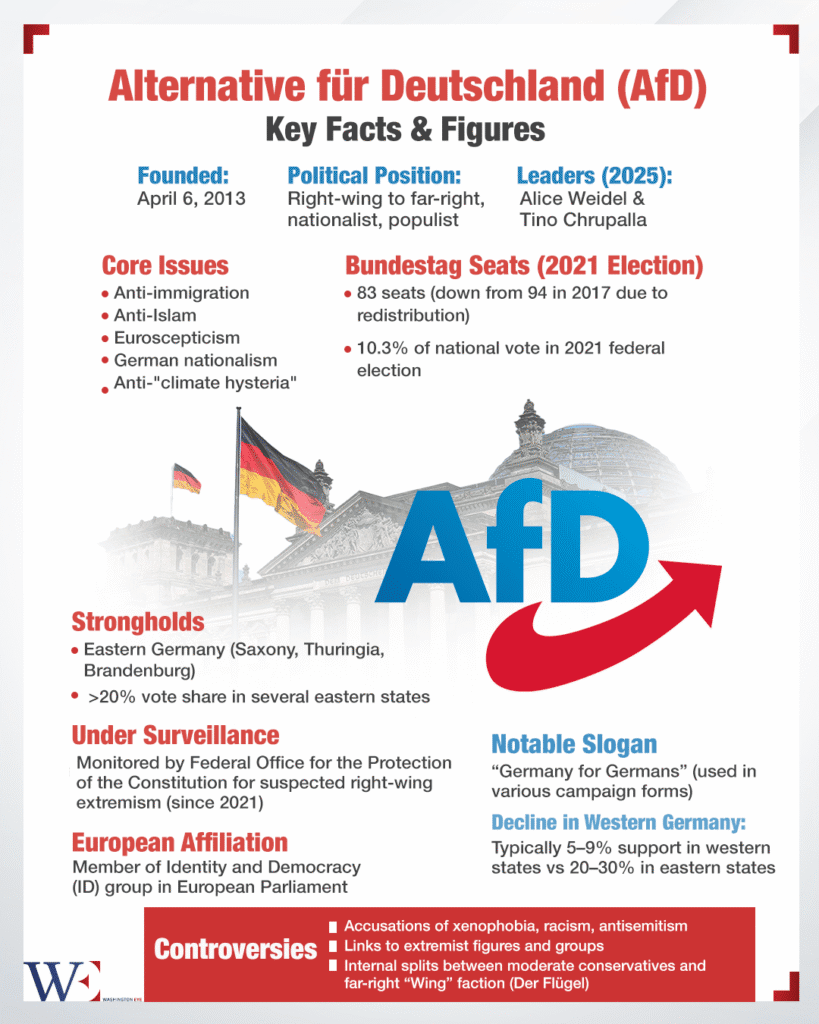Germany’s Federal Office for the Protection of the Constitution (BfV) officially classified the Alternative für Deutschland (AfD) as a “confirmed right-wing extremist” organization. This unprecedented move marks the first time since World War II that a major opposition party in Germany has been designated as a threat to the democratic order. The implications of this decision extend beyond Germany’s borders, offering a stark warning to right-wing movements globally, including those in the United States.
The AfD’s Descent into Extremism
The BfV’s 1,100-page report concluded that the AfD promotes an ideology centered on ethnic nationalism, particularly targeting Muslims and immigrants. The agency stated that the party’s conception of national identity, based on ethnicity and ancestry, violates human dignity and is incompatible with Germany’s democratic principles. This classification allows for intensified surveillance measures, including the use of informants and interception of communications.
Despite this designation, the AfD has maintained significant political support, securing over 20% of the vote in February’s general election and becoming the second-largest party in the Bundestag. This paradox highlights the tension between democratic resilience and the appeal of populist, exclusionary rhetoric.
Parallels with the American Right
The trajectory of the AfD bears striking similarities to certain elements within the American right. Both have experienced shifts from traditional conservatism toward more radical, nationalist ideologies. In the U.S., this is evident in the rise of movements that espouse anti-immigrant sentiments, question democratic institutions, and promote conspiracy theories.
For instance, the “Great Replacement” theory, which posits that native populations are being supplanted by immigrants, has gained traction among some American right-wing groups. This mirrors the AfD’s rhetoric on preserving German identity against perceived foreign influence. Additionally, the use of disinformation and challenges to electoral legitimacy in the U.S. echo the AfD’s undermining of democratic norms.
Mainstreaming of Extremism
One of the most troubling dynamics in both Germany and the United States is how once fringe ideologies have entered the political mainstream. In Germany, the AfD began as a Eurosceptic party and gradually absorbed xenophobic, ethnonationalist positions. Similarly, in the U.S., ideas once relegated to the political fringes—such as overt white nationalism or QAnon-style conspiracies—have gained influence within mainstream conservative discourse, especially through platforms like Fox News or via political figures amplifying such narratives.
Electoral Strategies Based on Cultural Backlash
Both AfD and parts of the American right capitalize on a sense of cultural loss or displacement. In Germany, the AfD’s popularity is strongest in eastern regions where economic discontent and demographic change fuel resentment. In the U.S., similar strategies appeal to rural and working-class white voters who feel alienated by multiculturalism, liberal social norms, or globalization. This politics of grievance is often framed not just as economic but as existential—a perceived fight for the “soul” of the nation.
Use of Lawfare and Institutional Subversion
AfD leaders have sought to delegitimize courts, press, and opposition parties. In the U.S., figures aligned with the far-right have attempted to do the same, often discrediting judges, intelligence agencies, and the electoral process itself. The January 6 Capitol riot was an extreme expression of this tendency—challenging democratic outcomes via extra-legal pressure. Although different in scale, the underlying belief that institutions are rigged or “deep state” controlled is a shared narrative.
Platforming via Social Media Echo Chambers
Both the AfD and far-right elements in the U.S. have benefited from the rise of alternative digital ecosystems where misinformation and radical views flourish. AfD figures frequently use Telegram and Facebook to bypass mainstream media filters, just as U.S. far-right influencers use X (formerly Twitter), Truth Social, and Rumble. The structural similarities in algorithm-driven radicalization are key in understanding how fringe movements gain traction quickly.
Youth Outreach and Ideological Grooming
A final, underreported parallel is the cultivation of younger demographics through targeted cultural messaging. AfD has developed youth wings such as “Junge Alternative”, known for its more openly radical stances, while U.S. equivalents include Turning Point USA and similar student organizations that combine anti-woke messaging with populist nationalism. These groups are not just political vehicles but identity-forming networks, suggesting that the right-wing radicalization pipeline is intergenerational and increasingly sophisticated.
A Final Note
Germany’s decision to classify the AfD as an extremist organization presents a unique case study in how states respond to political movements that challenge established constitutional frameworks. The move highlights the varying thresholds across democratic societies for when state intervention becomes justified in response to ideological developments within mainstream parties.
This action also raises broader questions about the role of intelligence services and judiciary institutions in policing political discourse. In some democratic systems, the emphasis is placed on institutional neutrality and procedural safeguards, while in others—like Germany—there is a historical precedent for proactive engagement when movements are perceived to contravene constitutional norms. These differences underscore the plurality of democratic models and their respective tolerances for ideological dissent, whether from the left or the right.
The implications are not merely legal or procedural, but also societal. When a party like the AfD retains substantial public support despite—or perhaps because of—state scrutiny, it reveals a disconnect between institutional classifications and popular sentiment. This tension can complicate governance, influence policy debates, and reconfigure coalition-building across the political spectrum.

















